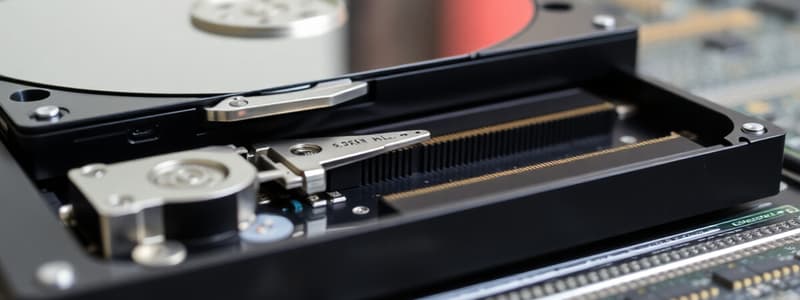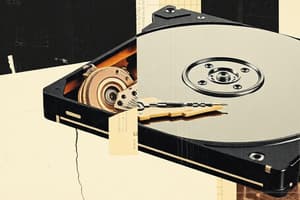Podcast
Questions and Answers
Which characteristic defines a Hard Disk Drive (HDD)?
Which characteristic defines a Hard Disk Drive (HDD)?
- It is a volatile storage device.
- It automatically erases data when power is lost.
- It stores data using flash memory.
- It employs a magnetic recording system to store digital information. (correct)
What materials are commonly used to construct the platters inside an HDD?
What materials are commonly used to construct the platters inside an HDD?
- Paper, cardboard, or fabric
- Plastic, rubber, or wood
- Aluminum, ceramic, or glass coated with a thin metallic alloy (correct)
- Copper, silver, or gold
What is the function of the read/write head in a Hard Disk Drive (HDD)?
What is the function of the read/write head in a Hard Disk Drive (HDD)?
- To regulate the temperature inside the drive.
- To read and write data on the magnetic surfaces of the platters. (correct)
- To control the rotational speed of the platters.
- To filter out dust particles from the air inside the drive.
What happens to the read/write heads in an HDD when the disk is spinning at full speed?
What happens to the read/write heads in an HDD when the disk is spinning at full speed?
What is the typical rotational speed of the platters in a modern HDD?
What is the typical rotational speed of the platters in a modern HDD?
If a platter within an HDD is analogous to the Earth, what would the read/write head be comparable to?
If a platter within an HDD is analogous to the Earth, what would the read/write head be comparable to?
Which of the following best describes a 'track' on an HDD?
Which of the following best describes a 'track' on an HDD?
In HDD terminology, what is a 'cylinder'?
In HDD terminology, what is a 'cylinder'?
What is the typical size of a sector in modern hard drives?
What is the typical size of a sector in modern hard drives?
In the context of HDD storage, what does a 'cluster' refer to?
In the context of HDD storage, what does a 'cluster' refer to?
Which formula accurately calculates disk size based on Cylinder, Head, and Sector (CHS) values?
Which formula accurately calculates disk size based on Cylinder, Head, and Sector (CHS) values?
What is anATA limitation on Cylinder, Head, and Sector (CHS)?
What is anATA limitation on Cylinder, Head, and Sector (CHS)?
What is the size limitation when both ATA and BIOS limitations are combined for Cylinder, Head, and Sector (CHS)?
What is the size limitation when both ATA and BIOS limitations are combined for Cylinder, Head, and Sector (CHS)?
What is the primary purpose of Logical Block Addressing (LBA) in hard drives?
What is the primary purpose of Logical Block Addressing (LBA) in hard drives?
What is the maximum capacity of LBA26?
What is the maximum capacity of LBA26?
Which memory type is used by Solid State Drives (SSDs) to store data?
Which memory type is used by Solid State Drives (SSDs) to store data?
Which interface types are most commonly used by SSDs to connect to a computer system?
Which interface types are most commonly used by SSDs to connect to a computer system?
How is data organized within the memory of an SSD?
How is data organized within the memory of an SSD?
In an SSD, what determines the total storage capacity of a block?
In an SSD, what determines the total storage capacity of a block?
How is information stored within the transistors of an SSD?
How is information stored within the transistors of an SSD?
Which of the following is generally true about SSDs compared to HDDs?
Which of the following is generally true about SSDs compared to HDDs?
What type of memory were early SSDs based on?
What type of memory were early SSDs based on?
What is one advantage of NAND flash-based SSDs over DRAM-based SSDs?
What is one advantage of NAND flash-based SSDs over DRAM-based SSDs?
What is the role of the controller in a NAND flash-based SSD?
What is the role of the controller in a NAND flash-based SSD?
What is the purpose of a capacitor in an SSD?
What is the purpose of a capacitor in an SSD?
What is a key characteristic of Single-Level Cell (SLC) NAND flash memory?
What is a key characteristic of Single-Level Cell (SLC) NAND flash memory?
Which type of NAND flash memory allows for higher storage density but has a shorter lifespan due to storing four bits of data per cell?
Which type of NAND flash memory allows for higher storage density but has a shorter lifespan due to storing four bits of data per cell?
What is the primary function of the TRIM command in SSDs?
What is the primary function of the TRIM command in SSDs?
Which metric is used by manufacturers to indicate the total amount of data that can be written to an SSD before it is likely to fail?
Which metric is used by manufacturers to indicate the total amount of data that can be written to an SSD before it is likely to fail?
What does MTBF (Mean Time Between Failures) indicate in the context of SSDs?
What does MTBF (Mean Time Between Failures) indicate in the context of SSDs?
Which storage device combines the features of both HDD and SSD technologies?
Which storage device combines the features of both HDD and SSD technologies?
What is the primary benefit of using an SSHD?
What is the primary benefit of using an SSHD?
In a system with both an SSD and an HDD as separate drives, how are these drives typically presented to the operating system?
In a system with both an SSD and an HDD as separate drives, how are these drives typically presented to the operating system?
What interface do hybrid systems typically use for connectivity?
What interface do hybrid systems typically use for connectivity?
What is the Master Boot Record (MBR)?
What is the Master Boot Record (MBR)?
Where is the Master Boot Record (MBR) located on a hard drive?
Where is the Master Boot Record (MBR) located on a hard drive?
Which of the following does the Master Boot Record (MBR) contain?
Which of the following does the Master Boot Record (MBR) contain?
What is the purpose of the Master Boot Code within the Master Boot Record (MBR)?
What is the purpose of the Master Boot Code within the Master Boot Record (MBR)?
What is the role of the GUID Partition Table (GPT) in disk partitioning?
What is the role of the GUID Partition Table (GPT) in disk partitioning?
Which of the following statements is correct about GPT?
Which of the following statements is correct about GPT?
What are the advantages of GPT over MBR?
What are the advantages of GPT over MBR?
Flashcards
HDD (Hard Disk Drive)
HDD (Hard Disk Drive)
Non-volatile storage device that retains information even without power.
HDD Structure
HDD Structure
Sealed unit containing platters coated with a magnetic alloy for data storage.
HDD Platters
HDD Platters
Disks of aluminum, ceramic, or glass coated with a magnetic alloy.
HDD Read/Write Head
HDD Read/Write Head
Signup and view all the flashcards
HDD Data Storage
HDD Data Storage
Signup and view all the flashcards
Head Floating
Head Floating
Signup and view all the flashcards
HDD Tracks
HDD Tracks
Signup and view all the flashcards
HDD Sector
HDD Sector
Signup and view all the flashcards
HDD Cluster
HDD Cluster
Signup and view all the flashcards
LBA (Logical Block Addressing)
LBA (Logical Block Addressing)
Signup and view all the flashcards
SSD (Solid-State Drive)
SSD (Solid-State Drive)
Signup and view all the flashcards
SSD Technology
SSD Technology
Signup and view all the flashcards
SSD Memory Organization
SSD Memory Organization
Signup and view all the flashcards
SLC (Single-Level Cell)
SLC (Single-Level Cell)
Signup and view all the flashcards
MLC (Multi-Level Cell)
MLC (Multi-Level Cell)
Signup and view all the flashcards
TLC (Triple-Level Cell)
TLC (Triple-Level Cell)
Signup and view all the flashcards
QLC (Quad-Level Cell)
QLC (Quad-Level Cell)
Signup and view all the flashcards
TRIM
TRIM
Signup and view all the flashcards
TBW (Terabytes Written)
TBW (Terabytes Written)
Signup and view all the flashcards
MTBF (Mean Time Between Failures)
MTBF (Mean Time Between Failures)
Signup and view all the flashcards
P/E Cycles (Program-Erase Cycle)
P/E Cycles (Program-Erase Cycle)
Signup and view all the flashcards
SSHD (Solid State Hybrid Drive)
SSHD (Solid State Hybrid Drive)
Signup and view all the flashcards
MBR (Master Boot Record)
MBR (Master Boot Record)
Signup and view all the flashcards
GPT (GUID Partition Table)
GPT (GUID Partition Table)
Signup and view all the flashcards
Study Notes
Hard Disks: Structure and Operation
- This details the structure and function of hard drives (HDD), solid-state drives (SSD), solid-state hybrid drives (SSHD), and logical structures like MBR and GPT.
HDD Introduction
- HDDs are non-volatile storage devices.
- HDDs retain your data even when there is no power.
- HDDs use a digital magnetic recording system.
- Solid-state drives (SSDs) use semiconductor-based memories for data storage.
HDD Physical Structure
- HDDs are hermetically sealed units.
- HDDs contains platters, typically two to four, made of aluminum, ceramic, or glass that are coated on both sides with a thin metallic alloy.
- The platters rotate simultaneously.
- The read/write head consists of vertically aligned arms that move inward or outward as needed.
HDD Operation
- A stack of disks or platters stores data magnetically.
- Platters have two magnetic surfaces: the upper and lower surfaces.
- Platters rotate at a constant speed, around 7200 rpm, approximately 129 km/h at the edge of the disk.
- Each side of the disk typically has a read/write head.
- The set of read/write heads move across the disk by a mechanical arm for reading or writing.
- The read/write heads do not touch the disk's surface when spinning.
- The heads float on an extremely thin layer of air, about 10 millionths of an inch, so any dust or impurities can damage them.
- Analogy: The HDD head is like a Boeing 747 flying 800 times the speed of sound less than a centimeter above the earth, registering every blade of grass.
HDD Zones
- Platter is an individual disk inside the hard drive.
- Cara is one of the two sides of the disk.
- Cabeza is the number of heads.
- Pista is a circumference within a side; track 0 is on the outer edge.
- Cilindro is a set of several tracks aligned vertically, one from each side.
- Sector de pista is each of the divisions of a track, with a standard size of 512 bytes.
- Sectors are the smallest units of information that can be read or written on the disk.
- Clúster is a set of track sectors.
HDD Geometry
- The HDD size is determined by cylinder, head, and sector (CHS).
- Size = Number of Heads x Number of Cylinders per head x Number of Sectors in a cylinder x Sector Size.
- Example: 16 heads x 6253 cylinders x 63 sectors x 512 bytes = 3 GB
HDD Geometry Limitations
- The ATA has a limit for Cylinder, Head, and Sector:
- 65536 Cylinders, 16 Heads, 256 Sectors totaling 128 GB.
- The BIOS has a limit for Cylinder, Head, and Sector:
- 1024 Cylinders, 256 Heads, 63 Sectors totaling 7.875 GB.
- ATA + BIOS limit for Cylinder, Head, and Sector:
- 1024 Cylinders, 16 Heads, 63 Sectors totaling 504 MB.
- LBA (logical block addressing) is a standard method for specifying the location of data blocks.
- LBA solves the limitations of ATA + BIOS, which is limited to 504 MB.
- LBA26 (26 bits) has a maximum capacity of 128 GiB, while LBA48 (48 bits) allows a maximum size of 128 PiB.
SSD Introduction
- SSD stands for Solid-State Drive.
- SSDs are data storage devices that use non-volatile memory, so they are not dependant on constant power.
- SSDs use a type of flash memory instead of magnetic disks.
SSD Physical Formats
- SSDs come in 2.5 and 3.5-inch formats, as well as the M.2 format.
- The bus interface determines the communication bus at the physical level, typically SATA3 and PCIe.
SSD Operation
- SSD technology is based on memory chips formed by NAND logic gates (transistors) that store bits.
- The physical organization of the memories: as a matrix structure with blocks divided into pages.
- The number of pages per block determines the total capacity of the SSD.
- Data is stored in transistors in two possible states (binary system).
- The charged state represents 0, while the discharged state represents 1.
SSD vs HDD
- SSD's are less susceptible to physical shock.
- SSD's are practically inaudible.
- SSD's have a lower access time and latency.
- SSD's consume less energy.
- SSD's are faster.
- SSD's have lower capacity.
- SSD's are more expensive.
SSD Architecture Based on DRAM
- SSDs were designed with DRAM memory chips and used in demanding server applications.
- SSDs can have very fast data access.
- SSDs incorporated an internal battery to provide backup power to ensure data persistence.
SSD Architecture Based on NAND Flash -Current Standard
- They do not require a constant power supply.
- They tend to be slower than DRAM-based SSD’s.
SSD Components
- Controladora:
- Connects the NAND memory components.
- Runs firmware-level code and one of the most critical factors in SSD performance.
- Caché is a small DRAM memory device similar to the cache in HDDs.
- Condensador is for storing data temporarily in case of power loss.
SSD NAND Cell Types
- Celda de nivel individual (SLC): Store only one bit of data per cell.
- These units are expensive and exceptionally durable.
- Celda de nivel múltiple (MLC): Store two bits of data per cell.
- These are less reliable, durable, fast, and advanced compared to SLCs.
- Triple bit por celda (TLC): Stores three bits of data per cell and have a lower price.
- Celda de nivel quadruple (QLC): Stores four bits and reduces their cost while exponentially reducing their lifespan.
- QLC’s only allow a one-hundred write or erase cycle limit
SSD TRIM Technology
- SSDs can store data at the row level, but can only delete data at the block level.
- Data from required files within a block must be moved to other locations before the block can be erased.
- TRIM marks data as unused by the OS rather than directly deleting it.
- The space they occupy can be rewritten directly at the row level, thus reducing the number of erase/write processes, and increasing the SSD's lifespan.
SSD Durability
- Manufacturers usually express durability information in 3 ways.:
- TBW(Terabytes Written): The number of terabytes of data that can be written to the drive before its complete failure.
- MTBF (Mean Time Between Failures): The average number of hours an SSD can operate before likely failure.
- P/E Cycles (Program-Erase Cycle): Specifies the number of write or delete cycles the SSD can withstand.
SSHD Introduction
- SSHD stands for Hybrid Drives or solid-state hybrid drives.
- SSHDs are hybrid solid-state units.
- SSHDs contain a large-capacity HDD and an SSD cache memory to improve access to frequently accessed data.
- A dual-drive hybrid system has an SSD and a HDD working independently in the same physical unit.
- The OS (operating system) will see two independent units that use the same interface as HDDs.
Disk Logical Structure
- Within the disk:
- The Master Boot Record also known as the boot sector or MBR is the first sector of the hard drive.
- Located physically at Head 0, Cylinder 0 and Sector 1 with a size of 512 bytes.
- Contains the Master Boot Code, or bootstrap loader and also a program that reads the Master Partition Table and loads the first sector of the active partition into memory, i.e., loads the VBR.
- The Master Partition Table contains information about the primary partitions, such as if they are active, their format, size in sectors, and the sector where they begin and end. The Sector Signature defines what the file is.
- GPT is a standard for the placement of the partition table on a hard disk.
- GPT supersedes the Master Boot Record (MBR)
- Uses the extended capabilities of EFI to initiate OS booting.
- It contains the MBR for protectivity and compatibility with legacy BIOS PC schemes
- A total of 32 sectors reserved are for GPT, leaving block LBA 34 as the first usable sector.
- The GPT header and partition table are written at both the beginning and the end of the disk.
- Contains an arbitrary number of partitions, depending on the assigned space by the partition table.
- There is no need for extended and logical partitions.
- Partitioned and/or unpartitioned space needs allocation.
- Partitioned space is needed to house the file systems, beginning with the first track of a cylinder and ending on the last.
- Unpartitioned space which has not been assigned to any partition is considered unused.
Studying That Suits You
Use AI to generate personalized quizzes and flashcards to suit your learning preferences.
Related Documents
Description
Explore the structure and operation of hard disk drives (HDDs), solid-state drives (SSDs), and solid-state hybrid drives (SSHDs). Learn about the physical components of HDDs, including platters and read/write heads. Understand how data is stored magnetically on platters and the function of MBR and GPT.




